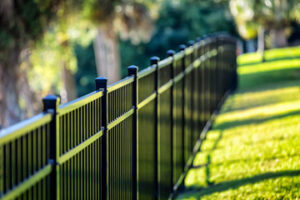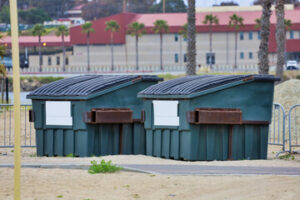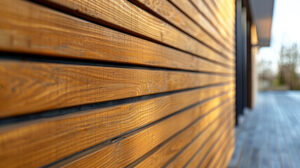Start a fencing business with a franchise to get a recognizable name, marketing support, and a proven business model. But be aware that franchises can be expensive.

Professional fence contractors use high-quality materials that will stand up to local weather conditions. They also buy products in bulk and can pass the savings on to you. Contact Fencing Companies Summerville SC for professional help.
Living in a noisy urban environment or close to a busy road isn’t just an inconvenience; it can actually damage your hearing and reduce your quality of life. It’s important to protect yourself from the noise pollution around you with a soundproof fence that will allow you to enjoy your outdoor spaces without the constant hum of traffic or barking dogs.
The best way to block out external noise is by using a fence made from dense, high-density materials like wood or concrete. These materials will prevent noise waves from passing through, resulting in a much quieter backyard environment. In addition, adding a layer of soundproofing material to your fence will further improve its noise-reducing capabilities.
There are several different types of noise-reduction fencing, each with its own unique benefits. Many fence companies provide acoustic fencing options that incorporate sound-absorbing materials like fiberglass, foam, and acoustic panels. These materials can be added to the fence structure itself or attached as an overlay, creating a seamless barrier that blocks out unwanted sounds.
Other noise-reduction fencing options include absorbing textures that can create an uneven surface to disrupt sound waves and diffuse them. These surfaces can also be designed to be aesthetically pleasing and complement the aesthetic of your backyard.
Another effective way to block out unwanted noise is to use acoustic fences that reflect sound waves back towards the source. This can be especially useful in commercial environments, as it helps to keep noises away from customers and office areas.
When choosing a noise-reducing fence, it’s important to consider where the noise is coming from and how loud it is. Online resources can help you identify the average noise levels in your area and neighborhood, allowing you to plan your soundproofing efforts accordingly.
It’s also important to regularly inspect your fence for any signs of damage or deterioration that could affect its noise-blocking abilities. If you notice any cracks, holes, or dents in your MLV or acoustic foam, be sure to repair them immediately to maintain the integrity of your fence and maximize its noise-reducing capabilities.
Security
Security Fencing is a Physical Layer of Defense
Security fences help prevent crime on commercial properties by reducing the likelihood of security breaches and minimizing the damage that could occur if a breach did happen. A fencing company can install multiple types of security fences that provide a range of benefits, including deterrence, visibility, and security.
An electric fence is a good example of security fencing that provides both a visual and physical barrier to trespassers. These fences use multiple wire strands that are triggered by touch and can be connected to sensors, sirens, and other devices that will sound and alert the owner of any attempts at intrusion.
A fencing company can also install cameras that will capture footage of trespassers and provide a visible deterrent. Cameras can also be linked to a monitoring system, which will notify security personnel of any trespassing and allow them to take immediate action.
In addition to the obvious benefits of deterrence and visibility, security fences can add a layer of protection by defining boundaries around restricted areas of a property. According to Automated Gate Services, this helps minimize the risk of theft, robbery, vandalism, and other unwanted activities on a property.
Another benefit of security fencing is that it can increase the value of a property by making the premises safer. For instance, an insurance company may offer a lower premium for a secure property. Additionally, a fence can help protect a business from wildlife that might cause harm or destruction, such as raccoons and squirrels.
Starting a fencing company is a great way to make money, be your own boss, and set your own schedule. To start, write a business plan to identify your customers and figure out how to stand out from competitors. Once you have a plan, begin advertising your services in your area and building the right reputation.
Property Value
Property value is a key factor that homeowners take into consideration when choosing fences. A new or upgraded fence can add a significant amount to a home’s value, providing a return on investment that makes it an attractive feature for prospective buyers. However, not all fences are created equal in terms of their effect on property value. Certain fencing choices and conditions can have a negative impact on a home’s worth, and should be avoided when possible.
Whether your fence is meant to enhance the aesthetic of your yard or provide functional benefits, it must complement the architectural style and natural surroundings of your home. Fences that clash with the overall design of your home can be jarring and distracting, thereby diminishing its appeal and reducing its property value.
When evaluating potential fencing companies, consider their reputation in the community and local market. You should also look into the company’s experience, service capabilities, and customer satisfaction ratings. Once you’ve narrowed down your options, choose a fence company that offers services tailored to the unique needs of your property and budget.
A fence’s ability to deter unauthorized access is an important feature that can increase your property’s safety and security. It can also offer a sense of privacy and peace of mind, which is an appealing quality for potential homebuyers. Furthermore, a well-maintained fence can help prevent noise and unwanted views from entering your home.
If your property is in a high-crime area, then a fence can be an excellent deterrent to both violent and property crime. It can also help you protect your children and pets from strangers, ensuring their safety. These are just some of the benefits of a fence that can boost your property’s value.
If you are looking for a business opportunity, then you may want to start a fencing company franchise. This way, you can have a recognizable name, and you will be supported by a successful business model and marketing support. However, it’s important to note that a franchise can be expensive, so you should carefully weigh your options and make sure that you’re comfortable with the initial investment.
Privacy
A privacy fence is a tall, solid structure that obstructs the view of one side of the property from the other. It is generally at least 6 feet tall and has very few or no gaps. Fence backer rails are attached to the posts for added structural support, and gate frames can be either metal or wood to allow access in and out of the yard.
A fence adds structure and a finished look to the property, which makes it more appealing and inviting for guests. It also increases the value of the home if it is ever put on the market, and it helps deter crime by creating a visual barrier. Fences are available in a variety of materials, including wood, vinyl, and chain link, but wood provides the best aesthetic and durability.
Fences can also help prevent fires from spreading to other structures or properties. They are effective barriers against the spread of smoke from chimneys and fireplaces, as well as the spread of flames from outdoor cooking equipment. In addition, fences can protect children and pets from falling off a deck or being injured by stray animals.
A good fence company will offer a wide range of fencing options to suit different tastes and budgets. They will also be able to recommend the right type of fence for the specific needs of each customer. For example, a homeowner with a small garden may be best served by a chain-link fence while a large, heavily populated backyard might require a high-security solution like an electric or security fence.
If you are looking to start a fencing company, you should first make sure that you have the necessary skills to run it successfully. You will need to have building and construction experience and be familiar with the types of fences that are available. In addition, you will need to know the laws in your area and what business registration requirements you will need to meet.
Once you have the skills and knowledge, it is time to launch your new business. You can begin by creating a website to showcase your services and provide information about the different fencing materials. You can also create social media profiles to reach out to potential customers. Finally, you should also print business cards and buy branded uniforms to create an authentic and professional image.








